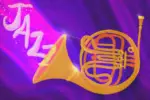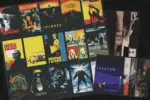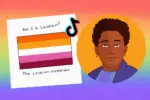2001. The world is still innocent, not yet scarred by the events that will transpire in New York City. All is quiet, and you manage to sneak downstairs to watch some late-night television while your parents are asleep. You catch the tail end of a funny Hanna-Barbera character interviewing Busta Rhymes before fading to commercial. Dang, you really wanted to catch that episode.
But just as you’re about to switch the TV off, the screen lights up with a series of flashing images, newspaper text and the blaring of jazz. The screen peels away, showing a silhouette of a man amid a field of blue. The lighting of a cigarette illuminates his face and frames it in shadow. ]he rest is history.
Cowboy Bebop – Opening | Tank! (youtube.com)
“Cowboy Bebop” is lauded as one of the best-written anime. Created by Shinichirō Watanabe, it has spawned a rich legacy and launched the careers of some of the most prolific voice actors in the industry today, such as the ever-recognizable Steve Blum. The level of influence that “Cowboy Bebop” has had on the animated world in the twenty-six years since its original 1998 release is undeniable.
So, let’s look back and see what made this story of a ragtag, found-family of bounty hunters so iconic in the eyes of fans the world over. How did one man’s cinematic take on the anime genre wind up propelling the art form to mainstream status?
“Cowboy Bebop” has been cited as many fans’ gateway into anime and for good reason. Its original English dub was the first anime shown as part of Adult Swim’s channel block during its launch back in 2001, serving as an action-packed and introspective contrast to the hilarity of shows like “Harvey Birdman, Attorney at Law” and “Space Ghost Coast to Coast.”
“Cowboy Bebop” is widely seen as one of the essential shows for those looking to get into anime for the first time. Not only is it a relatively short show—with only twenty-six episodes and a movie—but it also benefits from its broad range of influences. It’s a unique blend of Eastern and Western values and media, borrowing bits and pieces from somber Westerns and sci-fi spectacles with more than a few dashes of film noir and drama to spice it up.
Each episode features a different vibe while still being beholden to the overall aesthetic of the series. In one episode, you could be watching a fun little riff on “Alien,” featuring mutated lobster leftovers;the next, you’re watching protagonist Spike Spiegel duke it out with a psychic assassin whose grin would unnerve even The Joker.
If variety truly is the spice of life, then “Cowboy Bebop’s” has had the bulk of the spice cabinet poured into it and still manages to be mouth-wateringly great.
As its name suggests, “Cowboy Bebop” is inspired by music a great deal, and not just in how its soundtrack is utilized. . Its iconic soundtrack is heavily grounded in jazz motifs, balancing somber melodies amid the background of beautifully animated space with upbeat wailing once the fists and bullets start flying. This is a wild departure from the typical J-Pop soundtracks that anime at the time were rife with, and it gave the show a unique musical aesthetic that made it stand out all the more. There are also a great deal of other genres sprinkled into the episodes, such as the aptly titled “Heavy Metal Queen” episode taking inspiration from metal influences. Even if a watcher’s not a fan of jazz, there’s at least going to be one episode in “Cowboy Bebop” that’s going to have them headbanging along with the tunes.
One of “Cowboy Bebop’s” defining strengths is its ability to convey mature storytelling in a sophisticated manner. Anime at the time generally held a stigma for being geared towards children. The popularity of “Cowboy Bebop” upon release, and especially once the English Dub hit syndication for Western viewers, was one of the major factors in turning that predisposition on its head.
Unlike other shows around this time, “Cowboy Bebop” isn’t about physics-defying battles and lengthy speeches about the power of friendship. Instead, it is more grounded in its tone. It does not delve too deeply into melodrama that it becomes gratuitous, but neither does Watanabe drench the script with enough jokes to kill the drama. This is because, at its heart, it is a story about drifters stuck living in their pasts and the disconnect that comes from it. It anchors this story in a very relatable, very human center. All the gunfights and the bounty hunts are dressing, setpieces over a story that is all too human.
It is nothing short of a tonal masterpiece.
It’s only fitting that the series ushered in a slew of more mature-focused anime with the new millennium. Classics of the 2000s, such as “Fullmetal Alchemist” and “Death Note,” followed in “Cowboy Bebop’s” wake, emphasizing more mature themes and deeper characterization rather than the trope fulfilling character archetypes of the Shoenen action genre.
It has been over twenty-five years since the release of “Cowboy Bebop,” and it is still an enduring classic in the world of animation. It has stood the test of time as one of the most well-crafted and beloved works in the anime medium.

















